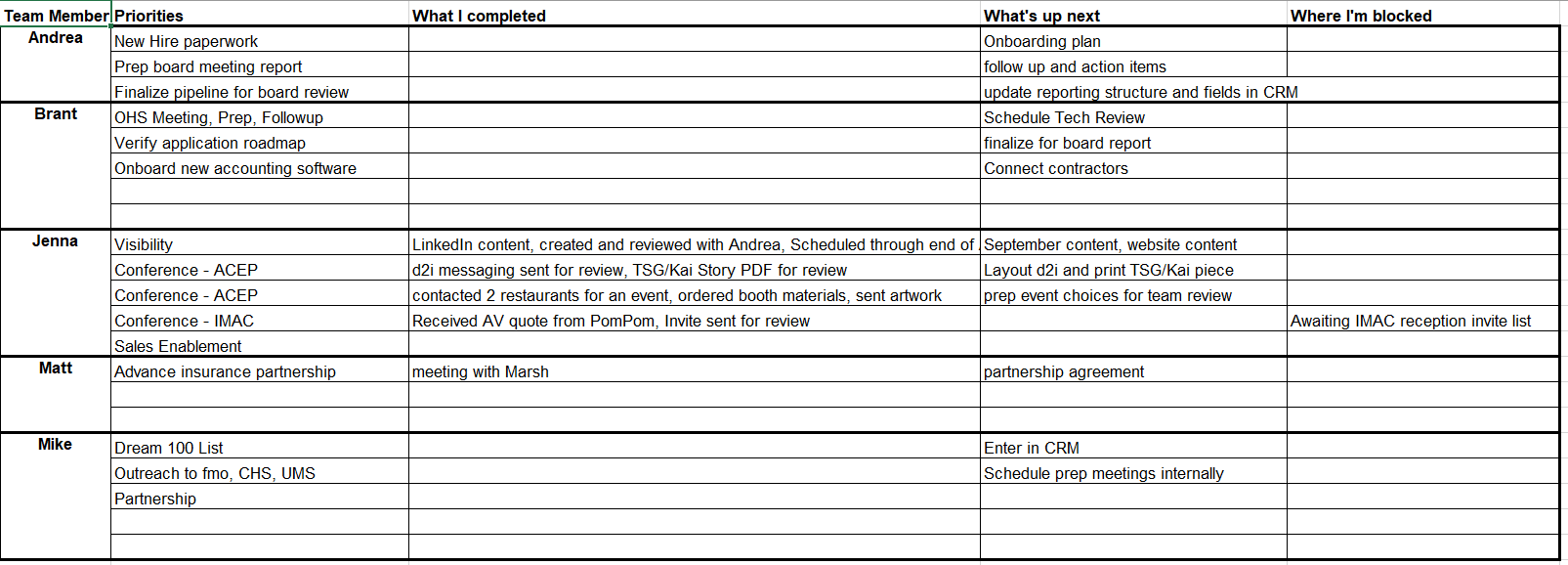If you've ever walked out of a meeting wondering what you just spent 90 minutes discussing, or if your team seems unclear about where they should be focusing their energy, you're not alone. Most businesses don't have a meeting problem—they have a clarity problem disguised as a meeting problem.
That's why I consistently reference and recommend Donald Miller's 5-meeting framework to my clients. It's not just another productivity hack—it's a strategic system that creates alignment from the top of your organization all the way down to individual priorities.
Why This Framework Changes Everything
Before I dive into the five meetings themselves, let me tell you why this framework is so transformative for the teams I work with:
It eliminates the priority guessing game. With this system in place, there should never be a question about what the company's priorities are, what your department's priorities are, or how those roll into each team member's individual priorities. Everyone knows where they stand and what matters most.
It surfaces misalignment early. As a leader, this framework helps you understand where your team members think they should be spending their time. If someone is off track from where you believe they should be focusing, you'll spot it immediately and can realign before weeks of effort go in the wrong direction.
It replaces update meetings with action meetings. When used correctly, this framework eliminates those dreaded 90-minute meetings where everyone takes turns reporting what they did last week. Instead, you zero in on the most important questions: Is everyone focused on the right things in the coming week? And what hurdles need to be cleared for them to move forward?
That shift from retrospective reporting to forward-focused problem-solving is game-changing.
The 5 Key Meetings
Donald Miller's framework consists of five essential meetings that, when implemented together, replace the chaotic meeting culture most businesses operate under.
1. The All-Staff Meeting (Weekly, 45-60 minutes)
This is your Monday morning alignment session where the entire organization comes together. The focus is threefold: reinforcing your company's three economic priorities through your mission statement, sharing departmental updates and wins, and celebrating team members who've gone above and beyond. This meeting keeps everyone energized and aligned around shared goals.
2. The Leadership Meeting (Weekly, after All-Staff)
This is where leaders discuss major initiatives, address roadblocks to economic objectives, and align on strategic direction. It's a focused space for your leadership team to work through challenges together and make sure nothing stands in the way of your organizational goals. For smaller businesses, you might combine this with the All-Staff Meeting but use a different agenda to shift the focus from broad updates to strategic leadership discussions.
3. The Department Stand-Up (Daily, <15 minutes)
These quick daily check-ins happen on days without an All-Staff Meeting. They're designed to keep teams nimble and focused on what matters most. Team members can bring up roadblocks, and the team can quickly brainstorm solutions to keep progress moving. The key is keeping them short—under 15 minutes—so everyone can get back to work with clarity.
4. The Personal Priority Speed Check (Weekly, 15 minutes)
These brief one-on-one meetings between department heads and individual team members focus on how their work aligns with company goals, address challenges, and offer guidance. Team members fill out a form about what they're working on before the meeting, ensuring you discuss the most important items. These check-ins make people feel recognized, valued, and clear about their contribution to company success.
5. Quarterly Performance Reviews (Quarterly, varies)
Regular performance reviews create a safe space where team members know how they're doing and where they stand. Both the team member and leader reflect on performance before the meeting, sparking honest conversations about expectations versus reality. These reviews set the stage for growth, compensation discussions, and give team members clear expectations—which is incredibly motivating.
How I Use the Priority Speed Check with Teams
The Department Stand-up is where I've seen the most dramatic transformation in team effectiveness. Rather than relying on verbal updates that get forgotten, I work with teams to create a digital update and priority tracker that becomes the foundation for these conversations.
Here's what makes this approach so powerful:
The tracker has four columns:
- Priorities: What are the 2-3 key priorities this team member is responsible for? These should map directly to departmental and company priorities.
- What I Completed: A brief record of progress made last week.
- What's Up Next: The specific tasks or milestones coming up this week.
- Where I'm Blocked: Any obstacles that need leadership support to remove.

Before the weekly check-in, each team member updates their section. This takes maybe 10 minutes, but it transforms the meeting from a status report session into a strategic problem-solving conversation. As a leader, you can scan the tracker before meetings and immediately see:
- Is everyone working on the right priorities?
- Where is progress happening?
- What roadblocks need your attention?
- Who might need realignment or additional support?
During the 15-minute meeting, you skip the "so, what have you been working on?" conversation and go straight to: "I see you're blocked on getting the IMAC reception invite list—let me connect you with Andrea who has that." Or: "I notice you have sales enablement as a priority but no tasks listed. Let's talk about whether that's still the right focus for you this quarter."
This approach respects everyone's time, creates documentation of priorities and progress, and most importantly, ensures that your team members are spending their limited attention on the work that matters most.
The Bottom Line
Donald Miller's 5-meeting framework isn't about having more meetings—it's about having the right meetings that create alignment, clear roadblocks, and drive your business forward. When you combine this framework with tools like the priority tracker, you create a culture where everyone knows what matters, why it matters, and exactly how they contribute to the bigger picture.
That's when teams stop being busy and start being focused. And focused teams get exponentially more done.
Want to dive deeper into the full framework and access Miller's fillable meeting templates? Read the complete guide to the 5 key meetings here.
Ready to build a FOCUS Culture™ in your organization? Let's talk about how these frameworks can transform your team's effectiveness. Schedule a consultation to explore customized solutions for your business.





